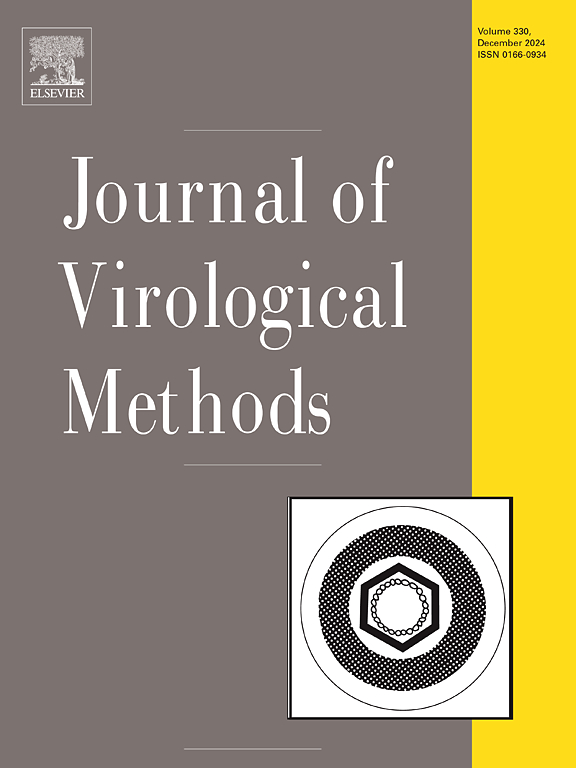Developing Zika virus-transduced hACE2 expression models for severe acute respiratory syndrome coronavirus 2 infection in vitro and in vivo
IF 1.6
4区 医学
Q3 BIOCHEMICAL RESEARCH METHODS
引用次数: 0
Abstract
To address the human ACE2 dependence for SARS-CoV-2 infection, this study presents a novel strategy for generating ZIKV-hACE2 single-round infectious particles (SRIPs) by incorporating the hACE2 gene into a Zika virus (ZIKV) mini-replicon. SARS-CoV-2 SRIP infection was significantly enhanced in HEK293T cells pre-infected with ZIKV-hACE2, as evidenced by increased cytopathic effects and elevated mRNA and protein levels of the SARS-CoV-2 nucleocapsid (N) protein. A mouse model was also developed with this approach to investigate SARS-CoV-2 infection. Immunohistochemical and real-time RT-PCR analyses confirmed the presence of the SARS-CoV-2 N protein in the lungs of mice injected with ZIKV-hACE2 SRIPs, indicating successful infection. The mouse model displayed COVID-19-like pathological changes, including increased macrophages in BALF, severe lung damage, and elevated pro-inflammatory cytokines (IL-6 and IL-1β). These features mimic severe COVID-19 cases in humans. Additionally, treatment with nirmatrelvir resulted in a 6.2-fold reduction in viral load and a marked decrease in N protein levels. Overall, this ZIKV mini-replicon-mediated hACE2 expression model, both in vitro and in vivo, is a valuable tool for studying SARS-CoV-2 infection and evaluating therapeutic interventions. The mouse model’s pathological features further underscore its relevance for in vivo research on SARS-CoV-2.
开发寨卡病毒转导的 hACE2 表达模型,用于严重急性呼吸系统综合征冠状病毒 2 的体外和体内感染
为了解决人类对SARS-CoV-2感染的ACE2依赖性,本研究提出了一种通过将hACE2基因整合到寨卡病毒(ZIKV)微型复制子中来产生ZIKV-hACE2单轮感染颗粒(srip)的新策略。在ZIKV-hACE2预感染的HEK293T细胞中,SARS-CoV-2的条带感染显著增强,细胞病变效应增强,SARS-CoV-2核衣壳(N)蛋白mRNA和蛋白水平升高。用这种方法还建立了小鼠模型来研究SARS-CoV-2感染。免疫组织化学和实时RT-PCR分析证实,在注射了ZIKV-hACE2基因片段的小鼠肺中存在sars - cov - 2n蛋白,表明感染成功。小鼠模型表现出covid -19样病理改变,包括BALF中巨噬细胞增加,肺损伤严重,促炎细胞因子(IL-6和IL-1β)升高。这些特征与人类严重的COVID-19病例相似。此外,用nirmatrelvir治疗导致病毒载量降低6.2倍,N蛋白水平显著降低。总之,这种寨卡病毒迷你复制子介导的hACE2体外和体内表达模型是研究SARS-CoV-2感染和评估治疗干预措施的有价值的工具。该小鼠模型的病理特征进一步强调了其与SARS-CoV-2体内研究的相关性。
本文章由计算机程序翻译,如有差异,请以英文原文为准。
求助全文
约1分钟内获得全文
求助全文
来源期刊
CiteScore
5.80
自引率
0.00%
发文量
209
审稿时长
41 days
期刊介绍:
The Journal of Virological Methods focuses on original, high quality research papers that describe novel and comprehensively tested methods which enhance human, animal, plant, bacterial or environmental virology and prions research and discovery.
The methods may include, but not limited to, the study of:
Viral components and morphology-
Virus isolation, propagation and development of viral vectors-
Viral pathogenesis, oncogenesis, vaccines and antivirals-
Virus replication, host-pathogen interactions and responses-
Virus transmission, prevention, control and treatment-
Viral metagenomics and virome-
Virus ecology, adaption and evolution-
Applied virology such as nanotechnology-
Viral diagnosis with novelty and comprehensive evaluation.
We seek articles, systematic reviews, meta-analyses and laboratory protocols that include comprehensive technical details with statistical confirmations that provide validations against current best practice, international standards or quality assurance programs and which advance knowledge in virology leading to improved medical, veterinary or agricultural practices and management.

 求助内容:
求助内容: 应助结果提醒方式:
应助结果提醒方式:


